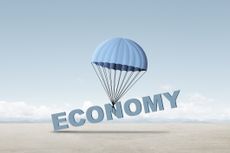Kiplinger Inflation Outlook: A Good Inflation Report Increases Investor Optimism
Odds of a Federal Reserve cut in interest rates are increasing.

Kiplinger’s Economic Outlooks are written by the staff of our weekly Kiplinger Letter and are unavailable elsewhere. Click here for a free issue of The Kiplinger Letter or to subscribe for the latest trends and forecasts from our highly experienced Kiplinger Letter team.
Inflation eased yet again in June, to 3.0%. Energy prices dropped for the second straight month. Prices excluding food and energy rose a modest 0.1%. New and used vehicle prices declined, with used prices down 10% over the past year. Medical services costs have risen by a smaller amount for three months in a row now. Airfares dropped for the fourth month in a row, on the heels of lower fuel costs.
The big news is that shelter costs rose by a modest 0.2%, their lowest monthly increase in nearly three years. Economists had long expected this, because market data on rents had been easing for a while. Housing is the largest single component of the price index, accounting for over a third of it. Inflation in services excluding shelter has been another Federal Reserve focus. This reading slowed to a 0.1% rise in June.

Sign up for Kiplinger’s Free E-Newsletters
Profit and prosper with the best of expert advice on investing, taxes, retirement, personal finance and more - straight to your e-mail.
Profit and prosper with the best of expert advice - straight to your e-mail.
Further progress on inflation in June raises the chances of a Federal Reserve interest rate cut, either in September or November. The Fed has been hesitant to make a move towards cutting rates until price increases in shelter and other services with a history of stubborn momentum started slowing down. Now, it appears that this is happening. Which month sees the first rate cut will likely depend on what the July and August inflation reports show.
Inflation reports in the next several months will likely not look as good as June’s. Energy prices have hit a floor, and the hot summer could send utility costs up. Other categories that can also have volatile price movements saw all the balls bounce in the same direction in June, allowing for the sizable dip in overall inflation. That may not be the case later in the year. Also, there are certain technical and seasonal adjustment factors that likely overstated the inflation slowdown in June. Nevertheless, even if shelter costs rise by 0.3% instead of 0.2% next month, and prices excluding food and energy rise by 0.2% instead of 0.1%, the Federal Reserve is likely to continue to see this as part of an overall downward inflation trend, keeping an interest rate cut on the table.
Annual inflation numbers for the rest of this year are not likely to dip below the current rate of 3.0%. That is the result of the relatively soft inflation that took place in the second half of 2023, which will make year-over-year comparisons in the upcoming CPI reports seem like little progress is being made. But analysts will be focused on the monthly changes since these will point to whether inflation is slowing now. If those monthly improvements materialize this summer, then expect the annual inflation rate to show a significant move towards the Fed’s target of 2% to 2.5% in the early spring of 2025.
Related content
Get Kiplinger Today newsletter — free
Profit and prosper with the best of Kiplinger's advice on investing, taxes, retirement, personal finance and much more. Delivered daily. Enter your email in the box and click Sign Me Up.

David is both staff economist and reporter for The Kiplinger Letter, overseeing Kiplinger forecasts for the U.S. and world economies. Previously, he was senior principal economist in the Center for Forecasting and Modeling at IHS/GlobalInsight, and an economist in the Chief Economist's Office of the U.S. Department of Commerce. David has co-written weekly reports on economic conditions since 1992, and has forecasted GDP and its components since 1995, beating the Blue Chip Indicators forecasts two-thirds of the time. David is a Certified Business Economist as recognized by the National Association for Business Economics. He has two master's degrees and is ABD in economics from the University of North Carolina at Chapel Hill.
-
 Hotels That Give You the Best Value for Your Money, According to Guests
Hotels That Give You the Best Value for Your Money, According to GuestsNew research reveals the best hotels in the U.S. for value for money according to hotel guests — and why they’re demanding more from their stay.
By Charlotte Gorbold Published
-
 Want to Earn $1 Million More Over Your Lifetime? Do This
Want to Earn $1 Million More Over Your Lifetime? Do ThisIt's simple: Go to college or a trade school. It's an investment that will pay huge dividends for the rest of your life. And the benefits go far beyond money.
By Brian Evans, CPA, PFS Published
-
 Car Prices Are Finally Coming Down
Car Prices Are Finally Coming DownThe Kiplinger Letter For the first time in years, it may be possible to snag a good deal on a new car.
By David Payne Published
-
 Rising Cyber Threat of AI: The Kiplinger Letter
Rising Cyber Threat of AI: The Kiplinger LetterThe Kiplinger Letter Security experts warn that generative AI brings new risks with no clear defenses. With AI's rapid adoption, businesses are vulnerable.
By John Miley Published
-
 Kiplinger Special: The Long-Term Future of the U.S. Economy
Kiplinger Special: The Long-Term Future of the U.S. EconomyThe Kiplinger Letter Kiplinger's report into what it will take the U.S. to maintain a healthy economic growth rate.
By David Payne Published
-
 The Fight Against Cancer Enters a New Phase
The Fight Against Cancer Enters a New PhaseThe Kiplinger Letter Breakthrough treatments hold promise for patients and investors.
By Matthew Housiaux Published
-
 After Decades of Promise, the Virtual Reality Era Has Finally Arrived
After Decades of Promise, the Virtual Reality Era Has Finally ArrivedThe Kiplinger Letter VR is a paradigm shift for consumer technology. The tech has a long road ahead, but amazing hardware already puts the huge potential on full display.
By John Miley Published
-
 AI to Power the Next Generation of Robots
AI to Power the Next Generation of RobotsThe Kiplinger Letter There's increasing buzz that the tech behind ChatGPT will make future industrial and humanoid robots far more capable.
By John Miley Published
-
 The Robots Are Coming... But Not For a While
The Robots Are Coming... But Not For a WhileThe Kiplinger Letter There’s excitement in the tech sector over the potential of humanoid robots, but widespread adoption is likely to be years away.
By John Miley Published
-
 Farmers Face Another Tough Year As Costs Continue to Climb: The Kiplinger Letter
Farmers Face Another Tough Year As Costs Continue to Climb: The Kiplinger LetterThe Kiplinger Letter Farm income is expected to decline for a second year, while costs continue to up-end farm profitability.
By Matthew Housiaux Published